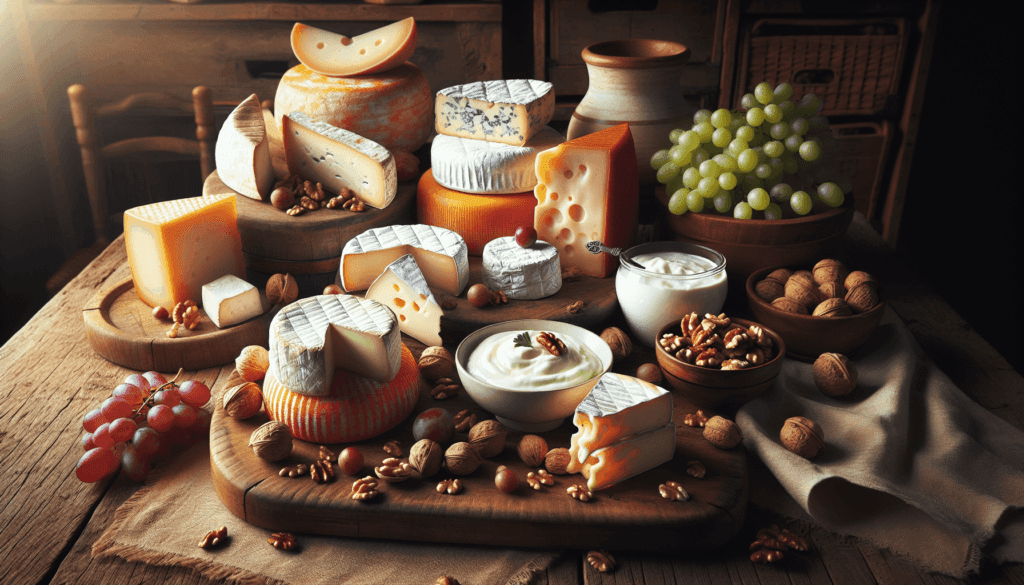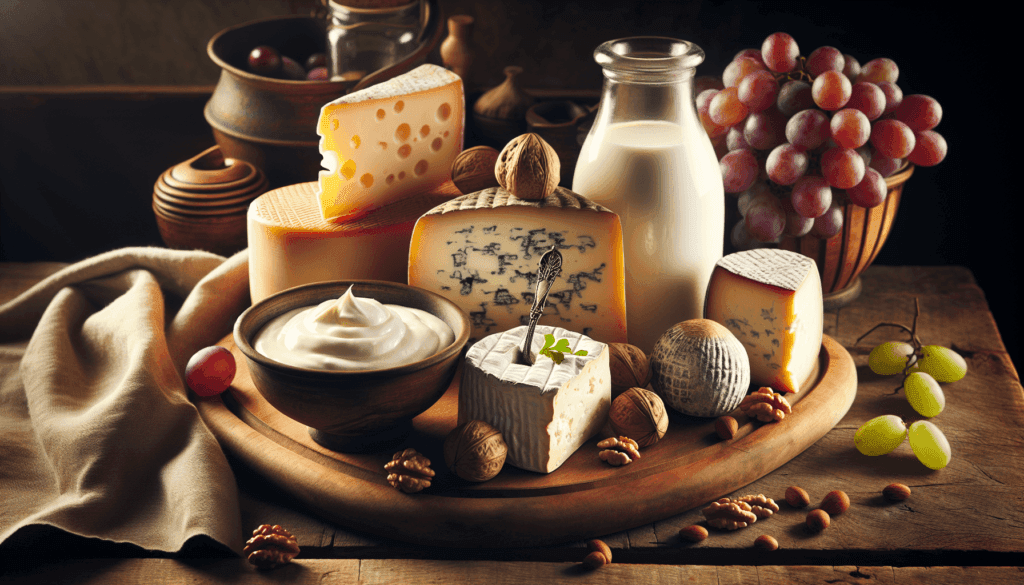Have you ever wandered into a local farmer’s market and found yourself mesmerized by the array of cheeses and yogurts, each promising a unique dance of flavors and textures? It’s a common conundrum for any dairy aficionado. This vast world of dairy delights is more than just a treat for your taste buds; it’s a gateway into local culture, tradition, and artisanal expertise. To help you navigate these delightful offerings, we’re embarking on a journey through the world of local cheeses and yogurts. Along the way, we’ll learn about their history, uncover key concepts, and discover how these delicious creations are made.

Table of Contents
The Rich History of Cheese and Yogurt
Understanding the origins of cheese and yogurt can deepen your appreciation for these dairy delights. These age-old foods have been part of human diets for thousands of years, with stories as rich and complex as their flavors.
The Ancient Art of Cheese Making
Cheese making dates back over 7,000 years, believed to have originated in Mesopotamia. Imagine for a moment that serendipitous accident where milk stored in a calf’s stomach—a natural rennet container—miraculously transformed into cheese. This humble beginning paved the way for countless varieties and techniques. Cheese culture evolved with each civilization, from Roman innovations to the refined techniques born in medieval monasteries.
Yogurt: A Gift from the Nomads
Much like cheese, yogurt boasts an ancient heritage, rooted in the early pastoral communities of Central Asia. Picture nomadic herdsmen, their leather bags swaying rhythmically as they crossed grassy steppes. The milk inside transformed into a tangy yogurt thanks to natural fermentation, offering both nourishment and preservation—a perfect invention for life on the move.
Understanding Cheese Varieties
As with any exploration of local delicacies, one must familiarize themselves with the basics. Understanding cheese varieties is akin to learning the alphabet—it forms the foundation of your culinary journey.
The Classic Categorization
Cheeses are typically categorized by their texture and flavor. Here’s a simple breakdown to help you recognize different types:
- Fresh Cheeses: Think mozzarella and feta. These cheeses are unaged and boast a soft texture with mild flavors.
- Soft-Ripened Cheeses: Includes brie and camembert. These are known for their velvety rind and creamy interior, maturing from the outside in.
- Semi-Soft Cheeses: Examples like gouda and havarti deliver moist, flexible textures and are often mild to medium in flavor.
- Hard Cheeses: Timeless classics like cheddar and parmesan. Firm and aged, they offer robust and concentrated flavors.
- Blue Cheeses: Whether it’s gorgonzola or stilton, these are distinguished by their blue veins of mold, providing characteristic tang and spice.
The Impact of Local Microclimates
Local cheese varieties often reflect their region’s microclimate and geography. For example, the lush pastures of Normandy lend their rich flavors to camembert, while the rugged terrain of the Mediterranean gives rise to tangy pecorino. It’s a testament to how the air, soil, and care of the region imprint on every wheel and wedge.

Yogurt: More Than Just a Breakfast Staple
Gone are the days of simply pairing yogurt with granola. This versatile dairy product has transcended its breakfast niche, offering a canvas for culinary creativity and health benefits.
Variations and Styles
Understanding the different styles of yogurt can be eye-opening:
- Traditional Yogurt: Made from whole milk with a creamy texture and fermented with live cultures.
- Greek Yogurt: Strained to remove whey, resulting in a thicker consistency and higher protein content.
- Skyr: Often mistaken for yogurt, this Icelandic product is thicker and more protein-packed.
- Kefir: A drinkable yogurt originating from the Caucasus, known for its tangy taste and probiotic richness.
Culinary Uses and Health Benefits
Yogurt’s tanginess makes it an ideal base for dressings, marinades, and desserts. Its probiotics can support gut health, while its nutritional makeup—a balanced offering of proteins, fats, and carbohydrates—marks it as a health-conscious choice.
The Artisanal Process: Perfecting Cheese and Yogurt
The cuisine reflects the cultural tapestry of the local area, and artisanal cheese and yogurt capture the heart and soul of craftsmanship.
The Cheese-Making Process
The journey from milk to cheese is a meticulous balance of art and science:
- Milk Selection: Cheese begins with milk, often influenced by the animal’s diet and the region’s climate.
- Coagulation: Addition of rennet or acids to curdle the milk, forming curds.
- Cutting and Draining: Curds are cut to release whey, with size influencing moisture content and final texture.
- Molding and Aging: The curds are shaped into molds and aged to develop flavor, a period ranging from days to years.
Yogurt: Crafting Consistency and Flavor
Turning milk into yogurt might sound straightforward, but true artisans perfect this process:
- Pasteurization: Heating milk to kill bacteria and ensure a clean canvas for fermentation.
- Culturing: Adding live bacterial cultures to inoculate milk, then incubating at controlled temperatures.
- Incubation: Maintaining the milk at ideal temperatures for bacterial growth and thickening.
- Cooling and Flavoring: Chilling stops fermentation, and flavors or fruits are added for variety.
Exploring Local Cheese and Yogurt Across Regions
It’s thrilling to explore how each region interprets cheese and yogurt through its lens of tradition and innovation.
The European Epitome: France and Italy
France and Italy arguably represent the zenith of cheese craftsmanship. Picture pungent Roquefort aged in caves or creamy burrata oozing from its pouch in Italy. In contrast, yogurt here is often infused with subtle flavors, from lavender to almond.
The Emerging Excellence: US and the UK
In recent years, artisanal cheese and yogurt have blossomed in the US and the UK. States like Wisconsin and Vermont boast rich cheesemaking traditions, while UK counties offer cheddar with regional distinction. Yogurt producers have embraced innovation, offering flavors to rival traditional options from across the pond.
Tasting and Pairing: The Magical Combinations
Knowing what pairs well with which cheese or yogurt can elevate your tasting experience to gourmet heights.
Cheese Pairing Basics
When pairing cheeses, consider balancing fat, acid, and tannins:
- Hard Cheeses: Like aged cheddar pair well with robust wines like cabernet sauvignon.
- Soft Cheeses: Such as brie harmonize with fruity wines like chardonnay.
- Blue Cheeses: Their sharpness complements sweet wines like port or desserts like honey-drizzled figs.
Yogurt Pairing Insights
Yogurt’s tang provides a versatile canvas:
- Savory Pairings: Use Greek yogurt in spicy dishes to cool and balance heat.
- Sweet Pairings: Top with fruit, nuts, or chocolate for a luxurious treat.
The Future of Local Cheese and Yogurt
Anticipate evolving trends as taste, technology, and sustainability drive the next generation of dairy delights.
Sustainable Practices
Producers have embraced eco-friendly practices, from renewable energy sources to sustainable animal feed. Consider supporting dairies that prioritize animal welfare and environmental stewardship.
Innovative Flavors and Textures
The future of cheese and yogurt promises inventive flavors—think truffle-infused cheese or beet-flavored yogurt—and textures. Artisans continually push the boundaries to create products that delight and inspire.
Conclusion: Embracing the Dairy Delight Journey
Whether you’re a seasoned connoisseur or a curious beginner, there’s always room to discover something new in the realm of cheese and yogurt. By understanding their rich histories, myriad varieties, and artisanal processes, you can better appreciate each delicious mouthful while supporting local traditions and responsible production practices.
Certainly, the dairy delights of local cheeses and yogurts hold an adventure worth savoring. Have you uncovered your new favorite variety or found a pairing that sings? Share your experiences, and who knows—maybe your next culinary creation will inspire others in the world of dairy delights.
